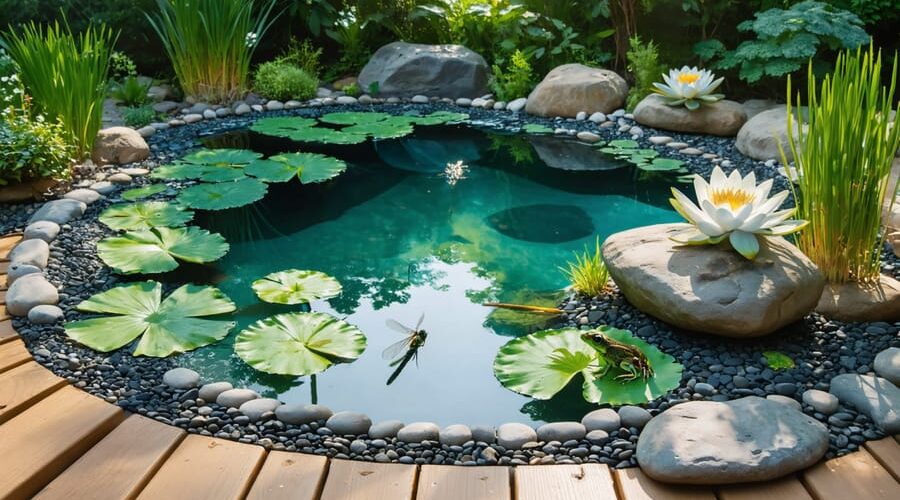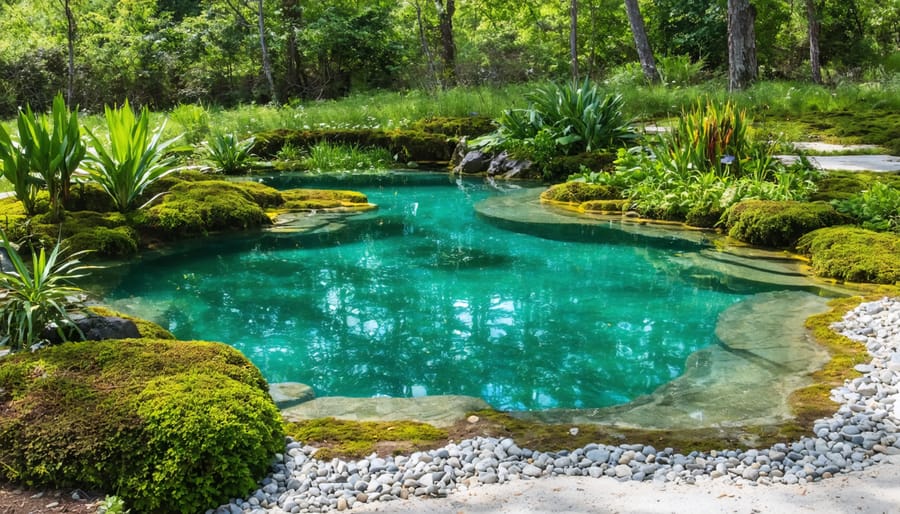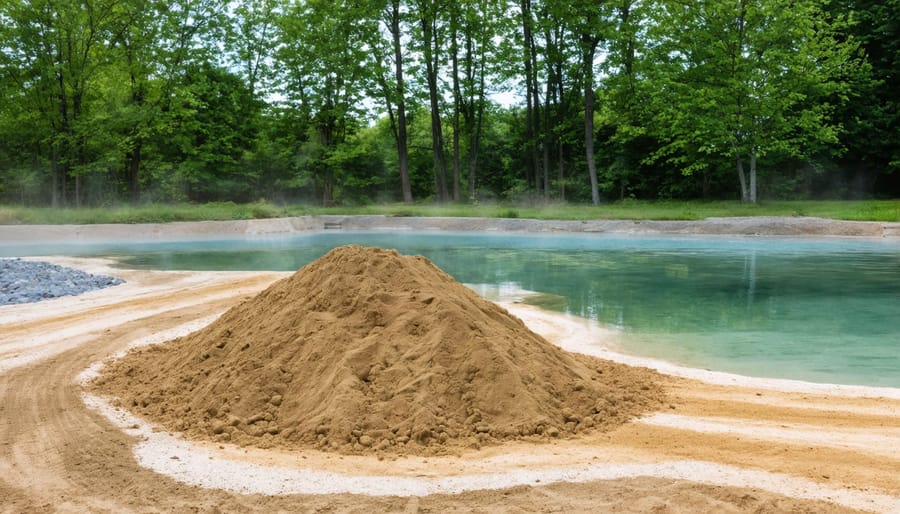
Why Your Wildlife Pond Needs an Ecosystem Pool (And How to Build One)
Imagine a pond that cleans itself, attracts colorful dragonflies and frogs, and requires less work than mowing your lawn. That’s the magic of an ecosystem pool—a beautifully balanced water feature that mimics nature’s own design principles to create a thriving, self-sustaining habitat right in your backyard.
Unlike traditional ponds that rely heavily on mechanical filters, chemicals, and constant intervention, an ecosystem pool harnesses natural processes to maintain crystal-clear water. Plants, beneficial bacteria, rocks, and gravel work together like a well-choreographed team, each playing a vital role in filtering water and supporting wildlife. The result? A stunning focal point that looks after itself while providing a sanctuary for birds, butterflies, and aquatic creatures.
What makes ecosystem pools particularly exciting for DIY water gardeners is their forgiving nature. These aren’t sterile swimming pools demanding perfect chemical balance—they’re living systems that actually improve with age as plants establish and beneficial organisms multiply. You’ll spend less time maintaining and more time enjoying the sights and sounds of your thriving aquatic ecosystem.
Whether you’re dreaming of a small wildlife-friendly feature or a larger naturalistic pond, understanding wildlife pond basics will set you on the path to success. This guide will walk you through everything you need to know—from the core principles that make ecosystem pools work to practical construction steps and realistic maintenance expectations that fit your lifestyle.
What Makes an Ecosystem Pool Different from a Regular Pond

The Natural Balance That Does the Work for You
Think of your ecosystem pool as a tiny forest in water—everything has a job, and together, they keep the whole system humming along. Instead of relying on expensive equipment and chemicals, you’re letting nature do what it does best: balance itself.
Here’s how the magic happens. Your pool becomes home to beneficial bacteria—the unsung heroes living on rocks, gravel, and plant roots. These microscopic workers break down fish waste and decaying leaves, converting harmful ammonia into harmless substances. It’s like having a cleanup crew that never takes a day off!
Plants act as natural filters, soaking up excess nutrients that would otherwise fuel algae blooms. Their roots create oxygen-rich zones where good bacteria thrive. Think of them as your pool’s living lungs and kidneys rolled into one.
The food web completes the picture. Insects feed on algae, small fish eat insects, frogs snack on mosquito larvae, and birds visit for a drink. Each creature plays a part in keeping populations in check. When I first built my pond, I worried about mosquitoes, but dragonfly nymphs moved in within weeks and handled that problem beautifully!
This interconnected system means fewer chores for you. No constant testing, scrubbing, or chemical adjustments. Once established—usually within a growing season—your ecosystem pool maintains itself through these natural relationships, giving you more time to simply enjoy watching the wildlife it attracts.
Why Wildlife Thrives in Ecosystem Pools
Wildlife absolutely loves ecosystem pools because they mimic the real deal—natural ponds and wetlands where creatures have thrived for millennia. Unlike traditional chlorinated pools, ecosystem pools use beneficial bacteria, aquatic plants, and natural filtration to maintain crystal-clear water without harsh chemicals. This creates a safe haven where dragonflies can lay eggs, frogs can breed without toxin exposure, and birds can drink and bathe safely.
The magic happens in layers. Shallow zones filled with cattails and irises become nurseries for tadpoles and hiding spots for baby fish. Deeper sections offer cool refuge during summer heat. Rocks and pebbles host biofilm—a fancy word for the slimy stuff that’s actually a buffet for aquatic insects and small invertebrates.
Year-round, your ecosystem pool becomes a wildlife restaurant. In spring, watch swallows swoop down for emerging insects. Summer brings butterflies sipping from water plants. Fall sees migrating birds stopping by for a drink. Even winter offers shelter in unfrozen pockets.
I’ve personally watched my own ecosystem pool transform into a wildlife hub within months—starting with water striders, then frogs calling at dusk, and eventually a heron visiting weekly. It’s incredibly rewarding to know you’ve created this thriving little world right in your backyard!
The Five Essential Elements Your Ecosystem Pool Must Have
Varied Depth Zones for Different Species
Creating different depth zones is like building a multi-story apartment building for your pond residents – everyone gets the floor that suits them best! Let’s start shallow and work our way down.
Your shallowest zone should be 10-20cm (4-8 inches) deep around the margins. This is prime real estate for frogs, who love to bask in the warm shallows, and visiting birds who need safe drinking and bathing spots. Think of it as the pond’s beach area!
The mid-depth zone, around 30-45cm (12-18 inches), is perfect for marginal plants. This is where you’ll establish most of your plants for different depths, creating vital habitats and filtration. Water lilies and other aquatic vegetation thrive here.
Finally, include at least one deeper section of 60-90cm (24-36 inches) or more. This depth remains cool in summer, providing refuge for fish during hot weather, and critically, it won’t freeze solid in winter, allowing creatures to safely overwinter below the ice layer. This temperature-stable zone is essential for a truly year-round ecosystem.

Native Aquatic Plants as Your Natural Filtration System
The magic of an ecosystem pool lies in its living filtration system—your aquatic plants! Think of them as nature’s cleanup crew, working 24/7 to keep your water crystal clear without electricity or expensive equipment.
Let’s break down the three types of plants you’ll need. **Oxygenators** live underwater, pumping oxygen into the water while absorbing excess nutrients that would otherwise feed algae. They’re like tiny factories that starve out the green stuff. **Marginal plants** sit along the edges in shallow water, their roots acting as biological filters that trap sediment and debris. **Floating plants** provide shade, cooling the water and blocking sunlight that algae love.
Here’s where it gets exciting—these native aquatic plants also create incredible habitat. Fish hide among their stems, dragonfly nymphs cling to their leaves, and frogs shelter in their shade.
**Beginner-friendly plants to start with:**
– Oxygenators: Hornwort, native Vallisneria
– Marginals: Native rush, water ribbons, sedges
– Floaters: Native water lilies, salvinia
I’ve watched my own pool transform over just one season—what started as murky water became clear enough to see fish darting around. Start with a variety from each category, covering about 60% of your pool’s surface, and let them work their natural magic!
Natural Substrate Instead of Liner-Only Construction
Traditional swimming pools rely entirely on plastic or rubber liners to hold water, creating a sterile environment. Ecosystem pools take a completely different approach by incorporating natural substrate layers—think gravel, sand, soil, and organic matter. This might sound messy at first, but here’s the beautiful part: these materials become home to billions of beneficial bacteria that naturally filter your water.
These microscopic helpers break down fish waste, decomposing leaves, and other organic debris that would otherwise cloud your water or require chemical treatment. The substrate also provides the perfect foundation for aquatic plants to root and thrive. Their roots create additional filtration while absorbing excess nutrients that algae would otherwise feast on.
Now, I know what you’re thinking—won’t all that dirt make the water murky? Initially, yes, you might see some cloudiness during setup. But once your ecosystem establishes itself over a few weeks, the beneficial bacteria colonies and plant roots actually create remarkably clear water. I’ve watched countless DIY pond builders amazed when their “muddy” pool transforms into crystal-clear water without any chemicals. The key is patience and trusting the natural processes to work their magic.
Gentle Water Movement Without Power-Hungry Pumps
One of the best parts about an ecosystem pool? You don’t need expensive, energy-draining pumps running 24/7. Gentle water movement is all you need to keep oxygen levels healthy for fish, frogs, and beneficial bacteria.
Solar-powered fountains are my go-to recommendation. They’re budget-friendly, require zero wiring, and create just enough ripple to oxygenate the surface without disturbing dragonfly larvae or tadpoles hiding in the shallows. I installed a small solar fountain in my wildlife pond last spring, and it’s been incredible watching birds splash in the gentle spray.
If your property has any slope, consider a gravity-fed stream. Using flexible liner and a few strategically placed rocks, you can create a trickling waterfall that feeds back into your pool naturally. The sound is wonderfully calming, and the cascading water adds oxygen without any electricity at all.
Even without these features, a well-designed ecosystem pool naturally circulates through temperature differences and wind action. Plants also help—submerged vegetation releases oxygen during daylight hours, doing much of the work for you.
Buffer Zones and Wildlife Corridors
Your ecosystem pool doesn’t exist in isolation—it’s part of a bigger picture! Think of the surrounding vegetation as a welcoming mat for wildlife. Native plants around your pool’s edges provide shelter, food, and safe pathways for creatures traveling between habitats. I learned this firsthand when I noticed frogs only started visiting my pond after I’d planted dense grasses nearby—they needed that protective cover.
Creating gentle slopes or strategically placed rocks gives animals easy access in and out of the water. Steep sides can trap small creatures, so always include escape routes. If possible, consider how your pool connects to other green spaces in your neighborhood. Even a small hedge or planted strip linking to a nearby park can serve as wildlife corridors, allowing birds, insects, and amphibians to move safely between areas.
These connections transform your pool from a standalone feature into a vital hub within your local ecosystem, supporting biodiversity far beyond your backyard boundaries.
Building Your Ecosystem Pool: A Step-by-Step Approach
Choosing the Right Location
Finding the perfect spot for your ecosystem pool is one of those decisions you’ll want to get right from the start. I learned this the hard way when I placed my first pond too close to a massive oak tree—spending every weekend fishing out leaves taught me that lesson quickly!
Aim for a location that receives 4-6 hours of sunlight daily. This sweet spot encourages beneficial plant growth without turning your pool into an algae spa. Too much shade means struggling plants, while full sun can overheat the water and stress your aquatic friends.
Check your drainage carefully. Your pool should sit in a naturally level area where rainwater won’t constantly flood in, bringing debris and chemicals from lawns. I always do the simple bucket test—pour water nearby and watch where it flows.
Keep at least 10-15 feet away from deciduous trees if possible. Those falling leaves will constantly upset your ecosystem’s balance and clog your filtration system.
Finally, think about accessibility. You’ll need to reach your pool for routine checks, feeding fish, and enjoying the fruits of your labor. A spot visible from your favorite window makes daily observation a pure joy.
Designing Your Depth Zones and Contours
Creating varied depth zones is where your ecosystem pool truly comes to life! Think of it as building an underwater neighborhood where each “level” attracts different creatures and plants.
Start by marking out three distinct zones with spray paint or stakes. Your **deep zone** (18-24 inches minimum) should occupy about 40% of your pool’s area—this gives fish a cool refuge in summer and prevents complete freeze-through in winter. I always place mine toward the center or north side where it stays naturally cooler.
Next, create your **marginal shelves** around the edges, about 6-12 inches deep and 12-18 inches wide. These are absolute goldmines for dragonflies, frogs, and marginal plants like pickerelweed and cattails. When excavating, angle these shelves slightly inward so soil doesn’t slide into deeper areas.
The **shallow zone** (2-6 inches) is your wildlife welcome mat! Dig a gradual beach-like slope on at least one side—think gentle ramp rather than cliff. Birds, small mammals, and beneficial insects need this safe access point for drinking and bathing.
Here’s my pro tip: as you dig, pile removed soil nearby rather than hauling it away immediately. You’ll need some for building up edges and creating natural-looking berms. Keep checking your depths with a measuring stick as you go—it’s much easier to remove a bit more soil than to add it back!

Installing Liner and Adding Substrate Layers
Once your excavation is complete, it’s time to create the foundation that will keep your ecosystem pool thriving for years to come. Start by removing any sharp rocks or roots from the bottom and sides—trust me, I learned this lesson the hard way when a hidden root punctured my first liner!
Lay down a protective underlayment first. This cushioning layer prevents punctures and extends your liner’s life dramatically. Overlap seams by at least six inches and don’t skimp on coverage up the sides. Next comes the liner itself, which you’ll want to position loosely without stretching. Let it settle naturally into the contours, working out major wrinkles by hand.
Here’s where strategy matters: adding substrate without creating a murky mess. Begin with larger rocks around the perimeter to anchor the liner edges. Then add a layer of clean, rinsed gravel (about 2-3 inches) across the bottom. Work from the edges inward, gently placing—not dumping—the gravel to minimize disturbance.
For planting shelves, add a layer of aquatic soil or clay topped with another inch of gravel. This “sandwich method” keeps soil particles contained while allowing plant roots to access nutrients. Fill the pool slowly with water as you add substrate layers, which helps everything settle naturally and reduces initial cloudiness. Your patience during this stage pays off with crystal-clear water once your ecosystem activates.
Maintaining the Balance: Seasonal Care That Actually Works
Spring: Waking Up Your Ecosystem
As temperatures warm, resist the urge to rush in and scrub everything clean—that’s the biggest beginner mistake! Your ecosystem has been quietly working all winter, and beneficial bacteria need time to reactivate. Start by gently checking water levels and topping off if needed. Remove only large debris like fallen branches; leave some leaf matter as it provides nutrients and habitat. If your plants have spread aggressively, now’s the time to divide them, but don’t disturb more than a third at once. **Never drain and power-wash your pond**—you’ll destroy the biological balance you’ve worked so hard to establish. Think of spring as a gentle wake-up call, not a deep clean. Your fish will become more active as water warms past 50°F, so gradually resume feeding. I learned this lesson the hard way my first year when I enthusiastically “cleaned” everything and spent months rebuilding my ecosystem!
Summer: Managing Algae the Natural Way
Summer warmth brings algae blooms—don’t panic! A little green water is actually a sign your ecosystem is working. The key is balance, not elimination. Add more submerged plants like anacharis or hornwort to compete with algae for nutrients. They’re nature’s water filters and grow like crazy in summer. Check that you’re not overfeeding fish, since uneaten food fuels algae growth. If things get too murky, add floating plants like water hyacinth to shade the surface—algae hates shade! Remember, crystal-clear water isn’t always healthy water. A slight green tint means your beneficial bacteria are thriving and your ecosystem is mature. Embrace the natural look!
Fall and Winter: Preparing for Dormancy
As temperatures drop, your ecosystem pool naturally shifts into rest mode—and honestly, that’s the beauty of it! Unlike traditional pools that demand extensive closing procedures, your wildlife pond needs minimal fuss. Leave those fallen leaves where they settle; they’ll break down slowly, providing insulation and food for microorganisms that keep your ecosystem ticking through winter.
Your fish will naturally slow down as water cools below 50°F. Stop feeding them once they become less active—they’ll survive beautifully on stored body fat and whatever tiny organisms they find. If your pond is at least 18-24 inches deep, it won’t freeze solid, giving fish and frogs safe zones to overwinter in the muddy bottom where temperatures stay above freezing.
Keep one small area ice-free using a pond heater or aerator. This isn’t about warmth—it’s about gas exchange, allowing harmful gases to escape while oxygen gets in. Frogs, newts, and turtles have found cozy spots in your leaf litter and muddy substrate by now, so resist any urge to “tidy up.” They’re counting on that messy blanket for survival!
Troubleshooting Common Ecosystem Pool Challenges
When Water Clarity Doesn’t Meet Expectations
Not all cloudy water means trouble! In a healthy ecosystem pool, you’ll sometimes see a slight green tinge or cloudiness—that’s actually good news, showing your beneficial bacteria are hard at work. The difference? Problem water has a murky brown color, unpleasant odors, or thick algae mats covering the surface.
If clarity becomes an issue, resist reaching for chemicals. Instead, check your plant coverage—aim for 50-60% surface shade with water lilies or floating plants to naturally reduce algae-feeding sunlight. Add more submerged plants like hornwort to compete with algae for nutrients. You can also install a simple mechanical filter or increase water circulation with an additional pump. Sometimes the fix is as simple as removing excess debris or reducing fish food portions. Remember, crystal-clear water isn’t always the goal—a slightly tinted, living ecosystem is perfectly natural and beautifully balanced.
Managing Overpopulation and Predators
Finding the right balance in your ecosystem pool sometimes means playing nature’s referee! If your fish population explodes, they’ll compete for resources and stress your system. The kindest solution? Rehome extras to fellow pond enthusiasts or local aquarium groups—many folks are thrilled to welcome healthy pond fish.
When herons, raccoons, or other predators discover your watery buffet, resist the urge to eliminate them entirely. They’re part of the natural cycle! Instead, create hiding spots with deep areas, overhanging plants, and underwater caves where fish can retreat. Fishing line strung across the pond surface (about 6 inches above water) confuses herons without harming them. Motion-activated sprinklers work wonders for deterring nighttime raiders like raccoons.
Managing predators naturally means accepting some losses while protecting your fish population overall. Remember, a truly sustainable ecosystem pool welcomes wildlife—even the challenging visitors—while maintaining protective measures that let everyone coexist peacefully in your backyard sanctuary.
Creating an ecosystem pool is one of the most rewarding projects you’ll ever tackle. Yes, it takes some effort upfront, but imagine a backyard water feature that practically takes care of itself—no harsh chemicals, minimal maintenance, and wildlife visiting daily. You’ll save money on expensive filtration systems and endless products, while gaining something priceless: a thriving, balanced ecosystem right outside your door.
I still remember the first dragonfly that landed on my cattails, and the evening I spotted a family of frogs claiming the shallow edges. These moments remind me why working with nature, rather than against it, makes all the difference.
Don’t feel overwhelmed—start small. Even a modest ecosystem pool can support incredible biodiversity. Add plants gradually, observe how your system develops, and expand when you’re ready. Nature is remarkably forgiving and adaptive.
Ready to transform your backyard? Grab a shovel, sketch your design, and take that first step. Your future self—and the wildlife that will call your pool home—will thank you. Let’s create something beautiful together.
